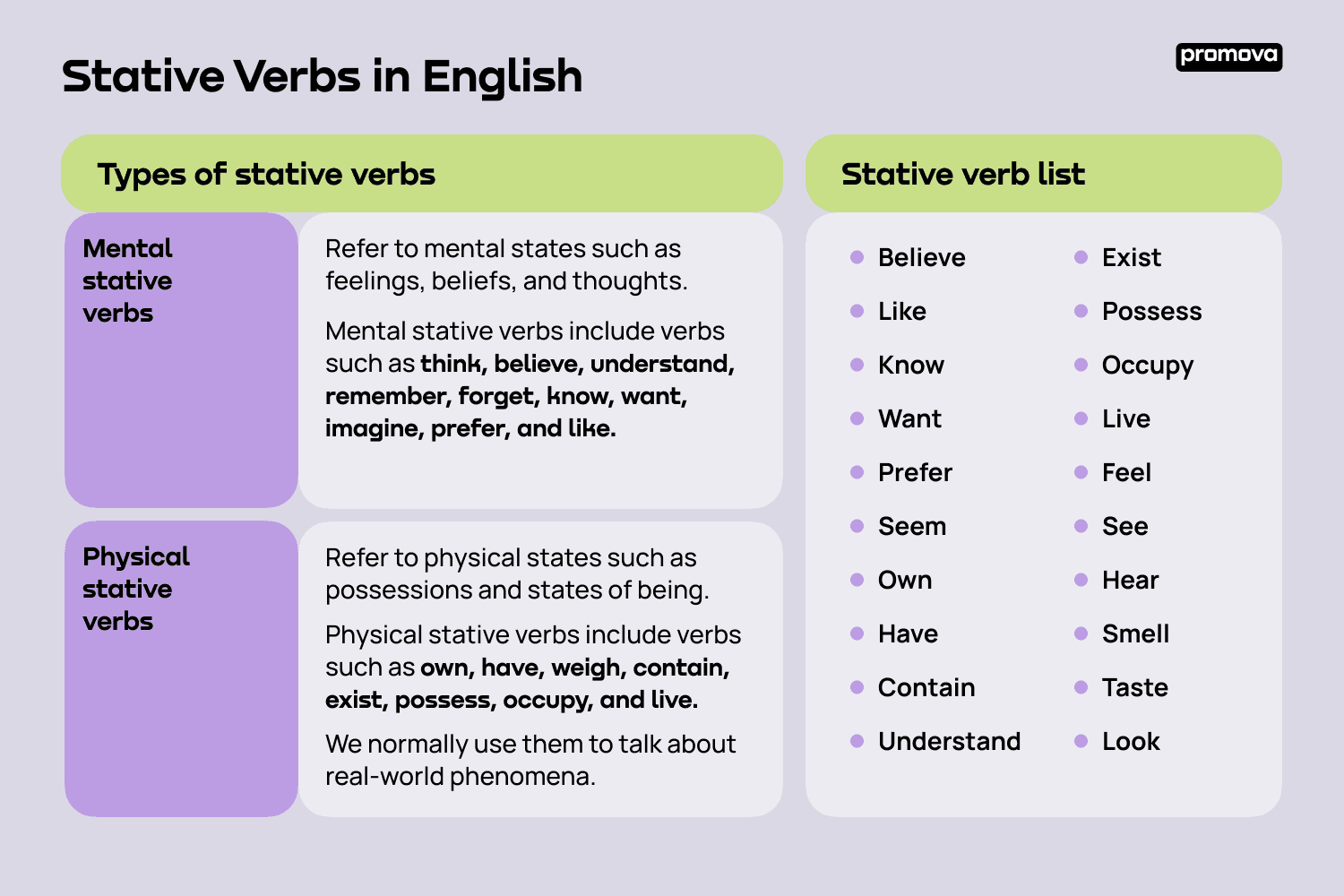Stative Verbs in English
Contents
In this reference, we’ll discuss stative verbs in great detail. We’ll look at what they are, the different types, how to use them, and common mistakes to avoid. We’ll also look at how to use them in questions and the present continuous.
What are stative verbs?
Stative verbs help us describe a state of being or a state of mind. They are not used to describe an action. These verbs are also known as “state verbs” or “state of being verbs.” Stative verbs usually refer to emotions, senses, beliefs, opinions, relationships, possessions, and states of being.
For example, “like,” “believe,” “know,” “see,” “feel,” “own,” and “love” are all stative verbs. They describe a state of being or a state of mind. They are not used to describe an action.
Types of stative verbs
Stative verbs can be broadly divided into two categories: mental and physical. Mental stative verbs refer to mental states such as feelings, beliefs, and thoughts. Physical stative verbs refer to physical states such as possessions and states of being.
Mental stative verbs include verbs such as think, believe, understand, remember, forget, know, want, imagine, prefer, and like.
Physical stative verbs include verbs such as own, have, weigh, contain, exist, possess, occupy, and live. We normally use them to talk about real-world phenomena.
Stative verb list
Here are some of the most common stative verbs in English:
- Believe
- Like
- Know
- Understand
- Want
- Prefer
- Seem
- Own
- Have
- Contain
- Exist
- Possess
- Occupy
- Live
- Feel
- See
- Hear
- Smell
- Taste
- Look

Examples of stative verbs in sentences
Examples of stative verbs in sentences:
- I believe in God.
- I like ice cream.
- I know the answer to the question.
- I understand the concept.
- I want a new car.
- I prefer vanilla ice cream.
- It seems like a good idea.
- I own a car.
- I have two cats.
- This box contains books.
- Life exists on other planets.
- I possess a great talent.
- They occupy the same space.
- We live in the same city.
- She feels sad.
- I see a bird.
- I hear a noise.
- I smell smoke.
- I taste sweet candy.
- She looks beautiful.
8
How to use stative verbs in English
Stative verbs are usually used in their simple form. This means that you use the infinitive form of the verb without “to.” For example, you say, “I believe,” not “I am believing.”
You cannot use the verb “to be” with the present participle of the verb. For example, you cannot say, “I am liking it.” Instead, you should say, “I like it.”
Common stative verb mistakes
Many English learners make the mistake of using stative verbs in the continuous form. This is incorrect because stative verbs are not usually used in the continuous form.
Another common mistake is using stative verbs with the verb “to be” in the simple form. For example, many people say, “I am knowing the answer,” but this is incorrect. The correct way to say this is “I know the answer.”
Stative verbs in questions
Stative verbs can be used in questions. However, they are usually used in a simple form. For example, you can say, “Do you understand?” or “Do you know the answer?”
Here are 5 more examples:
- Do you prefer chocolate or vanilla?
- Do you own a house?
- Do you have any pets?
- What is in the box?
- Do you believe in life on other planets?
Stative verbs in the present continuous
We rarely use stative verbs in the present continuous. However, there are some cases where it is acceptable to do it. These cases include when you are talking about a change in state or an action in progress.
For example, “I am understanding the concept” is acceptable because you are talking about a change in state. However, “I am knowing the answer” is not acceptable because you are not talking about a change in state.
Summary
Stative verbs help us describe a state of mind or a state of being. They are never used to describe an action. These verbs usually refer to emotions, senses, beliefs, opinions, relationships, possessions, and states of being.
We hope this reference article has helped you to better understand the concept and apply it in your own life! Check out the references below for more resources:



Comments